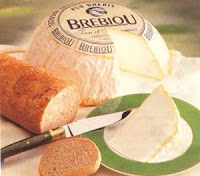Sainte Maure de Touraine cheese - commonly called "Sainte Maure" - originates from the former Touraine Province of France. This soft cheese has a distinctive, complex flavour, but mainly differs from other fresh chèvre's by being more firm and less spreadable as it ages, with a crust of bluish-gray surface mold.
A classic goat cheese with the defining feature of rye straw running through the center that originally helped hold the cheese in shape, but now it’s more traditional than anything. Producers engrave the straw with their name to ensure quality control. The cheese is almost two pounds, which represents the milk output of a goat in a single day (around two liters). In order to legally call your cheese Sainte-maure-de-Touraine it must be made from the milk of goats who live and eat in the Touraine area of the Loire valley. The cheese is rubbed with a mixture of salt and wood ash to form the rind. It has a short aging period of about 10 days, at which point the chalk white cheese has a smooth texture and fresh, mildly goaty taste. The rind adds just a bit of zing.
Summer is the best season for goat cheeses. Not only are they generally on the fresher side, they also tend to be lower in fat than their cow and sheep’s milk counterparts. As such, they have the light, refreshing flavor you’re looking for when temperatures start to climb. Plus they pair well with summer produce like tomatoes and zucchini. Try with a light and fruity red wine, Bourgueil, Chinon, Gamay and Cabernet d'Anjou, or a dry white wine from Touraine.
A classic goat cheese with the defining feature of rye straw running through the center that originally helped hold the cheese in shape, but now it’s more traditional than anything. Producers engrave the straw with their name to ensure quality control. The cheese is almost two pounds, which represents the milk output of a goat in a single day (around two liters). In order to legally call your cheese Sainte-maure-de-Touraine it must be made from the milk of goats who live and eat in the Touraine area of the Loire valley. The cheese is rubbed with a mixture of salt and wood ash to form the rind. It has a short aging period of about 10 days, at which point the chalk white cheese has a smooth texture and fresh, mildly goaty taste. The rind adds just a bit of zing.
Summer is the best season for goat cheeses. Not only are they generally on the fresher side, they also tend to be lower in fat than their cow and sheep’s milk counterparts. As such, they have the light, refreshing flavor you’re looking for when temperatures start to climb. Plus they pair well with summer produce like tomatoes and zucchini. Try with a light and fruity red wine, Bourgueil, Chinon, Gamay and Cabernet d'Anjou, or a dry white wine from Touraine.


















































